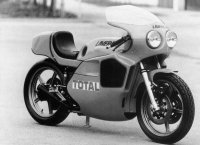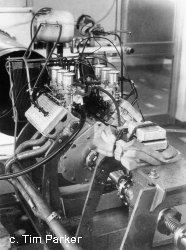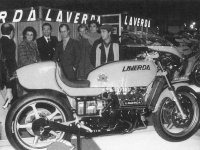EARLY DEVELOPMENT
 The V6 engine was primarily a technical adventure, debate surrounds whether it was ever really intended to be a production
bike. It was an investigation into multi cylinders,
4 valve heads, watercooling, electronic ignition and - in the initial stages -
fuel injection.
The V6 engine was primarily a technical adventure, debate surrounds whether it was ever really intended to be a production
bike. It was an investigation into multi cylinders,
4 valve heads, watercooling, electronic ignition and - in the initial stages -
fuel injection.
The project began in 1976 when it was becoming clear that the twins and triples were no longer at the cutting edge of performance. In spite of the fact that the Jota was still the speed king of the road, Massimo knew that a new range of four stroke engines were required to meet the ever tightening noise and emission requirements and -more importantly- to retain Laverda's awesome reputation for making fast bikes that didn't break.
The engine was the product of Massimo, Luciano Zen and Guilio Alfieri.
Zen had a significant history with the Laverda factory, right back to the construction of the very first 75cc utility bike in 1947. Alfieri on the other hand was brought in on a consultative
basis after distinguished achievements; he was Maserati's technical
director  and
designer of the V6 engine that powered the Merak Coupe - the influence
of which can be clearly seen in the Laverda engine. With all of his experience in automotive engineering Alfieri's initial work was bulky, and it was Massimo to constantly steer the esteemed head engineer toward a smaller and more compact product. Those who have seen the Vee Six will attest that this goal was more than achieved, the powerplant being much smaller than you might imagine.
and
designer of the V6 engine that powered the Merak Coupe - the influence
of which can be clearly seen in the Laverda engine. With all of his experience in automotive engineering Alfieri's initial work was bulky, and it was Massimo to constantly steer the esteemed head engineer toward a smaller and more compact product. Those who have seen the Vee Six will attest that this goal was more than achieved, the powerplant being much smaller than you might imagine.
The bike was first displayed at the 1977 Milan show to amazed onlookers, it's facts and figures were:
ENGINE: Configuration; 90° vee six, Bore & stroke; 65x50mm, Capacity; 996cc, Valve operation; chain driven double overhead cam per bank, Valve angle; 25°, Valve sizes; 24mm inlet, 23.5mm exhaust, Induction; six 30mm downdraught Dell’Orto carburetors, Lubrication; five litre dry sump with two oil pumps, Cooling; six litre water cooling with twin radiators
CHASSIS: Frame; Tubular spaceframe with engine as stressed member, Forks;
38mm Marzocchi, Wheels; one-off FLAM 5-spoke wheels,
Brakes; 280mm Brembo discs with twin piston calipers all round, cantilever
rear suspension with underslung rear shock absorber. 
Initial tests of the engine proved promising, it's very first dyno run registering just short of 120bhp. Further development saw an incredible 140bhp@11,800rpm whilst retaining a mile wide powerband - perfectly suitable for a road bike. The team were confident that 160bhp would have been easily attainable without sacrificing the engine's excellent spread of power.
1978... 1000cc... 160hp- WOW!
These figures are really quite staggering and serve to underline how 'right' the engine itself was from the outset. It was now time to put this awesome engine into a bike and test it. After creating a groundbreaking engine, the project now had to find a way of getting all that power to the ground.

